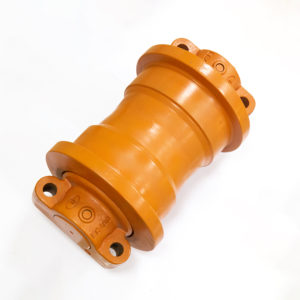Proper storage of spare track rollers is crucial to ensure their longevity and optimal performance when they are needed.
Here are some best practices for storing spare track rollers:
Cleanliness: Before storing track rollers, make sure they are thoroughly cleaned to remove any dirt, debris, or contaminants. Use a soft brush or compressed air to clean all surfaces of the rollers.
Lubrication: Apply a thin coat of lubricating oil or rust inhibitor to the surface of the track rollers to prevent corrosion during storage. This helps protect the rollers from moisture and oxidation.
Packaging: Wrap each track roller individually in a protective material, such as plastic or paper, to safeguard them from dust, moisture, and potential physical damage. Ensure that the packaging material is clean and dry.
Storage Environment: Choose a storage area that is clean, dry, and preferably indoors to protect the track rollers from extreme temperature variations, humidity, and direct sunlight. Avoid areas prone to excessive dust or chemical exposure.
Positioning: Store the track rollers in an upright position to prevent distortion or deformation. If storing multiple rollers, stack them carefully, ensuring that the weight is evenly distributed to avoid unnecessary stress.
Supporting Surface: Place the track rollers on a clean and flat surface to prevent any warping or uneven wear. Consider using pallets or racks to keep them off the ground and protect them from moisture.
Regular Inspection: Periodically inspect the stored track rollers to ensure they remain in good condition. Look for signs of corrosion, damage, or any other issues that may require attention.
Rotation: If you have multiple spare track rollers, implement a rotation system to prevent prolonged storage of a single roller. This helps distribute usage and ensures all rollers are regularly inspected and maintained.
Documentation: Keep a record of the storage location, date of storage, and any relevant information about the track rollers. This helps with inventory management and ensures proper tracking of the rollers’ storage history.
Handling: When handling the stored track rollers, use proper lifting equipment or techniques to avoid dropping or mishandling them. excavator track roller Rough handling can lead to damage or premature wear.
By following these best practices, you can help preserve the integrity and longevity of spare track rollers, ensuring they are ready for use when needed and minimizing the risk of damage or deterioration during storage.
Can track rollers affect fuel efficiency and overall operating costs of an excavator?
Yes, track rollers can have an impact on fuel efficiency and overall operating costs of an excavator. Here’s how:
Friction and Resistance: Track rollers, along with other undercarriage components, contribute to the overall friction and resistance between the tracks and the ground. Excessive friction can increase the load on the engine, resulting in higher fuel consumption. Worn or poorly maintained track rollers can increase friction and resistance, leading to decreased fuel efficiency.
Track Alignment: Proper alignment of the track rollers is essential for smooth movement of the tracks. Misaligned or poorly adjusted track rollers can cause the tracks to drag or bind, increasing resistance and fuel consumption. Regular inspection and adjustment of track rollers can help maintain proper track alignment and reduce energy losses.
Track Wear and Tension: Track rollers help support and guide the tracks. Worn or loose tracks can increase rolling resistance, requiring the engine to work harder and consume more fuel. Adequate track tension, facilitated by well-maintained track rollers, helps reduce excessive track wear and associated fuel inefficiencies.
Component Interactions: The condition of track rollers can affect the performance of other undercarriage components, such as sprockets, idlers, and track links. A worn or damaged track roller may cause uneven wear or premature failure of these components, leading to increased maintenance and repair costs.
Durability and Lifespan: High-quality track rollers designed for durability and longevity can reduce the frequency of replacements and associated downtime. Choosing reliable track rollers that can withstand the demands of the excavator’s operating conditions can help minimize operating costs.
It’s important to note that while track rollers can influence fuel efficiency and operating costs, they are just one component within a complex system. Other factors, such as engine efficiency, machine design, operator behavior, and maintenance practices, also play significant roles in determining fuel consumption and operating costs.
Regular maintenance, including proper lubrication, inspection, and timely replacement of worn track rollers, can help optimize fuel efficiency, reduce unnecessary wear, and contribute to overall cost savings in the long run. Additionally, working with an experienced equipment operator and following best practices for operating an excavator can further enhance fuel efficiency and minimize operating expenses.
